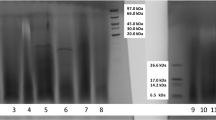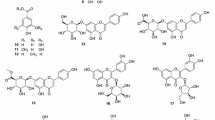Abstract
As part of our study of the isolation of antihypertensive agents derived from natural marine products, the bioactivity of 10 edible Korean seaweeds were screened by angiotensin converting enzyme (ACE) inhibitory and peroxynitrite assays. Among the crude extracts of selected sea-weeds, including five Phaeophyta (Ecklonia stolonifera, E. cava, Pelvetia siliquosa, Hizikia fusiforme, and Undaria pinnatifida), four Rhodophyta (Gigartina tenella, Gelidium amansii, Chondria crassicaulis, and Porphyra tenera) and one Chlorophyta (Capsosiphon fulvescens), the ethanol extracts of E. stolonifera, E. cava, P. siliquosa, U. pinnatifida, and G. tenella exhibited significant inhibitory properties against ACE at more than 50% inhibition at a concentration of 163.93 μg/mL. Phloroglucinol 1, eckstolonol 2, eckol 3, phlorofucofuroeckol A 4, and dieckol 5 had been isolated previously, and triphlorethol-A 6 and fucosterol 7 were isolated for the first time from E. stolonifera. Also, the ACE inhibitory and peroxynitrite scavenging properties of phlorotannins 1–6 were evaluated, along with fucosterol 7 obtained from E. stolonifera. Among profound peroxynitrite scavenging compounds 1–6, phlorotannins 3, 4 and 5 were also determined to manifest marked inhibitory activity against ACE, with 50% inhibition concentration (IC50) values of 70.82±0.25, 12.74¯0.15, and 34.25±3.56 μM, respectively.
Similar content being viewed by others
References
McFarlane SI, Kumar A, Sowers JR. Mechanisms by which angiotensin-converting enzyme inhibitors prevent diabetes and cardiovascular disease. Am. J. Cardiol. 2003; 91 (Suppl.): 30H-37H.
Cleland JGF, Swedberg K, Poole-Wilson PA. Successes and failure of current treatment of heart failure. Lancet 1998; 352: S119-S128.
Ueno H, Horie S, Nishi Y, Shogawa H, Kawasaki M, Suzuki S, Hayashi T, Arisawa M, Shimizu M, Yoshizaki M, Morita N. Chemical and pharmaceutical studies on medicinal plants in Paraguay. Geraniin, an angiotensin-converting enzyme inhibitor from “Paraparai mi,” Phyllanthus niruri. J. Nat. Prod. 1988; 51: 357–359.
Sato M, Hosokawa T, Yamaguchi T, Nakano T, Muramoto K, Kahara T, Funayama K, Kobayashi A, Nakano T. Angiotensin I-converting enzyme inhibitory peptides derived from Wakame (Undaria pinnatifida) and their antihypertensive effect in spontaneously hypertensive rats. J. Agric. Food Chem. 2005; 50: 6245–6252.
Liu JC, Hsu FL, Tsai JC, Chan P, Liu JYH, Thomas GN, Tomlinson B, Lo MY, Lin JY. Antihypertensive effects of tannins isolated from traditional Chinese herbs as non-specific inhibitors of angiotensin converting enzyme. Life Sci. 2003; 73: 1543–1555.
Kang DG, Kim YC, Sohn EJ, Lee YM, Lee AS, Yin MH, Lee HS. Hypotensive effect of butein via the inhibition of angiotensin converting enzyme. Biol. Pharm. Bull. 2003; 26: 1345–1347.
Chen CH, Lin JY, Lin CN, Hsu SY. Inhibition of angiotensin-I-converting enzyme by tetrahydroxyxanthones isolated from Tripterospermum lanceolatum. J. Nat. Prod. 1992; 55: 691–695.
Okada Y, Ishimaru A, Suzuki R, Okuyama T. A new phloroglucinol derivative from the brown alga Eisenia bicyclis: potential for the effective treatment of diabetic complications. J. Nat. Prod. 2004; 67: 103–105.
Noda H, Amano H, Arashima K, Hashimoto S, Nisizawa K. Studies on the antitumour activity of marine algae. Nippon Suisan Gakkaishi 1989; 55: 1259–1264.
Kim YC, An RB, Yoon NY, Nam TJ, Choi JS. Hepatoprotective constituents of the edible brown alga Ecklonia stolonifera on tacrine-induced cytotoxicity in Hep G2 cells. Arch. Pharm. Res. 2005; 28: 1376–1380.
Ahn MJ, Yoon KD, Kim CY, Min SY, Kim YU, Kim HJ, Kim JH, Shin CG, Lee CK, Kim TG, Kim SH, Huh H, Kim JW. Inhibition of HIV-1 reverse transcriptase and HIV-1 integrase and antiviral activity of Korean seaweed extracts. J. Appl. Phyhcol. 2002; 14: 325–329.
Fukuyama Y, Kodama M, Miura I, Kinzyo Z, Mori H, Nakayama Y, Takahashi M Structure of an anti-plasmin inhibitor, eckol, isolated from the brown alga Ecklonia kurome Okamura and inhibitory activities of its derivatives on plasma plasmin inhibitors. Chem. Pharm. Bull. 1989; 37: 349–353.
Fukuyama Y, Kodama M, Miura I, Kinzyo Z, Mori H, Nakayama Y, Takahashi M. Anti-plasmin inhibitor. VI. Structure of phlorofucofuroeckol A, a novel phlorotannin with both dibenzo-1,4-dioxin and dibenzofuran elements, from Ecklonia kurome Okamura. Chem. Pharm. Bull. 1990; 38: 133–135.
Nagayama K, Shibata T, Fujimoto K, Honjo H, Nakamura T. Algicidal effect of phlorotannins from the brown alga Ecklonia kurome on red tide microalgae. Aquaculture 2003; 218: 601–611.
Kang HS, Kim HR, Byun DS, Son BW, Nam TJ, Choi JS. Tyrosinase inhibitors isolated from the edible brown alga Ecklonia stolonifera. Arch. Pharm. Res. 2004; 27: 1226–1232.
Shin HC, Hwang HJ, Kang KJ, Lee BH. An antioxidative and anti-inflammatory agent for potential treatment of osteoarthritis from Ecklonia cava. Arch. Pharm. Res. 2006; 29: 165–171.
Choi JS, Lee JH, Jung JH. The screening of nitrite scavenging effect of marine algae and active principles of Ecklonia stolonifea. J. Korean Fish. Soc. 1997; 30: 909–915.
Kang HS, Chung HY, Kim JY, Son BW, Jung HA, Choi JS. Inhibitory phlorotannins from the edible brown alga Ecklonia stolonifera on total reactive oxygen species (ROS) generation. Arch. Pharm. Res. 2004; 27: 194–198.
Kang HS, Chung HY, Jung JH, Son BW, Choi JS. A new phlorotannin from the brown alga Ecklonia stolonifera. Chem. Pharm. Bull. 2003; 51: 1012–1014.
Park CS, Hwang EK, Lee SJ, Roh KW, Sohn CH. Age of growth of Ecklonia stolonifera Okamura in Pusan bay, Korea. Bull. Korean Fish. Soc. 1994; 27: 390–396.
Kurata K, Taniguchi K, Shiraishi K, Suzuki M. Ecklonialactones C-F from the brown alga Ecklonia stolonifera. Phytochemistry 1993; 33: 155–159.
Taniguchi K, Kurata K, Suzuki M. Feeding-detergent effect of phlorotannins from the brown alga Ecklonia stolonifera against the abalone, Haliotis Discus Hannai. Nippon Suisan Gakkaishi 1991; 57: 2065–2071.
Park DC, Ji CI, Jung KJ, Lee TG, Kim IS, Park YH, Kim SB. Characteristics of tyrosinase inhibitory extract from Ecklonia stolonifera. J. Korean Fish. Soc. 2000; 3: 195–199.
Lee SH, Lee YS, Jung SH, Kang SS, Shin KH. Anti-oxidant activities of fucosterol from the marine algae Pelvetia siliquosa. Arch. Pharm. Res. 2003; 26: 719–722.
Fukuyama Y, Miura I, Kinzyo Z, Mori H, Kido M, Nakayama Y, Takahashi M, Ochi M. Eckols, novel phlorotannins with a dibenzo-p-dioxin skeleton possessing inhibitory effects on α2-macroglobulin from the brown alga Ecklonia kurome Okamura. Chem. Lett. 1985; 6: 739–742.
Hou WC, Chen HJ, Lin YH. Antioxidant peptides with angiotensin converting enzyme inhibitory activities and applications for angiotensin converting enzyme purification. J. Agric. Food Chem. 2003; 51: 1706–1709.
Kooy NW, Royall JA, Ischiropoulos H, Beckman JS. Peroxynitrite-mediated oxidation of dihydrorhodamine 123. Free Radic. Biol. Med. 1995; 16: 149–156.
Kim OK, Park YB, Lee TG, Kim IS, Kang JH, Jun KS, Park DC, Kim SB. Degradation of nitrite as a nitrosamine precursor by brown algae. Ecklonia cava. J. Korean Fish. Soc. 1996; 29: 914–916.
Heo SJ, Jeon YJ. Antioxidant effect and protecting effect against cell damage by enzymatic hydrolysates from marine algae. Food Industry Nutr. 2005; 10: 31–41.
Lee YS, Lee SH, Kim BK, Shin KH. Screening for aldose reductase inhibitory activity of extracts of the marine plants from Korea. Algae 2004; 19: 349–352.
Lee SH, Lee YS, Jung SH, Shin KH, Kim BK. Effects of the extracts from Pelvetiasiliquosa on metabolism regulation in rats. Kor. J. Pharmacogn. 2004; 35: 203–206.
Park YB, Kim IS, Yoo SJ, Lee JH, Park DC, Yeum DM, Lee TG, Kim SB. Elucidation of anti-tumor initiator and promoter derived from seaweed-1: anti-tumor promoting activity of seaweed extracts. J. Korean Fish. Soc. 1996; 29: 917–919.
Park JW, Lee MJ, Yoon HM, Kim CH. Nitrite scavenging activity of the ethanol and water extracts obtained from Hizikia fusiforme and Sargassum fulvellum. Korean J. Life Sci. 2001; 11: 321–327.
Okai Y, Higashi-Okai K. Identification of antimutagenic activities in the extract of an edible brown seaweeds, Hizikia fusiforme (Hijiki) by the umu gene expression system in Salmonella typhimurium (TA1535/pSK1002). J. Sci. Food Agric. 1994; 66: 103–109.
Lee YS, Shin KH, Kim BK, Lee SH. Anti-diabetic activities of fucosterol from Pelvetia siliquosa. Arch. Pharm. Res. 2004; 27: 1120–1122.
Athukorala Y, Jeon YJ. Screening for angiotensin I-converting enzyme inhibitory activity of Ecklonia cava. J. Food Sci. Nutr. 2005; 10: 134–139.
Glombitza KW, Pauli K. Fucols and phlorethols from the brown agla Scytothamnus australis Hook. et Harv. (Chnoosporaceae). Bot. Marina 2003; 46: 315–320.
Myung CS, Shin HC, Bao HY, Yeo SJ, Lee BH, Kang JS. Improvement of memory by dieckol and phlorofucofuroeckol in ethanol-treated mice: possible involvement of the inhibition of acetylcholinesterase. Arch. Pharm. Res. 2005; 28: 1376–1380.
Nakagawa K, Ueno A, Nishikawa Y. Interactions between carnosine and captopril on free radical scavenging activity and angiotensin-converting enzyme activity in vitro. Yakugaku Zasshi 2006; 126: 37–42.
Hagiwara H, Wakita KC, Inada Y, Hirose S. Fucosterol decreases angiotensin converting enzyme levels with reduction of glucocorticoid receptors in endothelial cells. Biochem. Biophys. Res. Commun. 1986; 139: 348–352.
Author information
Authors and Affiliations
Corresponding author
Rights and permissions
About this article
Cite this article
Jung, H.A., Hyun, S.K., Kim, H.R. et al. Angiotensin-converting enzyme I inhibitory activity of phlorotannins from Ecklonia stolonifera . Fish Sci 72, 1292–1299 (2006). https://doi.org/10.1111/j.1444-2906.2006.01288.x
Received:
Accepted:
Issue Date:
DOI: https://doi.org/10.1111/j.1444-2906.2006.01288.x




